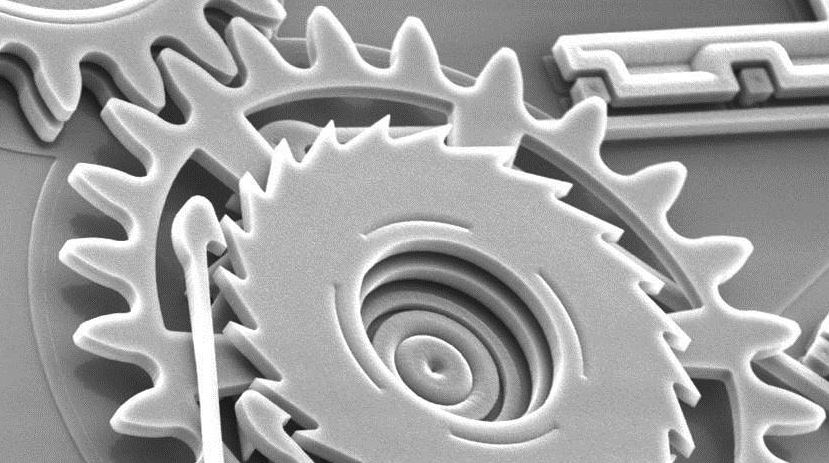
当前课程知识点:计算几何 > 04. Voronoi Diagram > L. Divide-And-Conquer > 04-L-11. Avoiding Rescans
好了 我们对于算法的优化方法
自然也就水到渠成了
具体来说我们可以指定任何一个点
作为起始点
如果我们需要找到
第一条边所潜在对应的
那个第一个交点的话
我们只需要从起点开始
沿着这个cell的边界
向前逐边的搜索
显然应该会找到这个点
我们为此花费的成本
其实就是这两个点之间的
那段弧的长度
接下来如果有必要去寻找第二条边
所对应的那个第二个潜在的交点的话
这里与刚才那种蛮力方法不同的就在于
我们只需从刚才那个
失效的交点出发
而不是继续的从起点出发
就可以逐条边的搜索之后
找到第二个交点
再强调一遍
在这样的一个过程中
本质的不同在于
我们的起点只是刚才停留下来的那个点
而不必每次都回到原始的那个起点
不管是第二个点
还是有可能有第三个 第四个 第五个点
我们的所有的这些交点的求法
都可以在前一个交点的基础上继续搜索
它的成本无非就是连续的两个交点之间的
那样一段弧的长度
而总体来看
相对于这样的一个相对固定的cell而言
所有的这些查找
都变成了分段的局部的模式
它们的总体成本
累积起来也不过就是它们之间的
这样一系列弧的长度总和
这个长度的总和
其实必然不会超过这个cell的轴长
是多少呢 线性的
请记住这个成本虽然也是线性的
但它是总体的线性的
而不是像刚才
我们那种蛮力的算法那样
是每一次求每一个结点都是线性的
现在是求所有的交点
累积起来的成本不过是线性的
好了 在解决了这样的一个关键问题之后
我们就自然可以心安理得的
得出这样的一个结论
两张Voronoi图
在刚才的那样模式下的合并工作
所需要的成本
必然是不超过线性的
而基于这样的一个合并的基本的算法
按照分而治之的框架
所得到的总体的
那个Voronoi图的构造的算法
它的复杂度自然也就不超过O(nlogn)了
O(nlogn)是什么呢
正是我们刚才所证明的那个下界
从这个意义上讲
我们已经得到了一个
在最坏情况下
最优的Voronoi图的构造算法
-Before we start
--html
-Evaluation
--html
-Online Judge
--html
-Lecture notes
--html
-Discussion
--html
-A. History of This Course
--00-A. History of This Course
-B. What's Computational Geometry
--00-B. What's Computational Geometry
-B. What's Computational Geometry--作业
-C. How to Learn CG Better
--00-C. How to Learn CG Better
-C. How to Learn CG Better--作业
-D. Why English
-A. Convexity
-A. Convexity--作业
-B. Extreme Points
-B. Extreme Points--作业
-C. Extreme Edges
-C. Extreme Edges--作业
-D. Incremental Construction
--01-D-01. Decrease and Conquer
--01-D-02. In-Convex-Polygon Test
--01-D-03. Why Not Binary Search
-D. Incremental Construction--作业
-E. Jarvis March
--01-E-06. Lowest-Then-Leftmost
-E. Jarvis March--作业
-F. Lower Bound
--01-F-02. CAO Chong's Methodology
-F. Lower Bound--作业
-G. Graham Scan: Algorithm
-G. Graham Scan: Algorithm--作业
-H. Graham Scan: Example
-H. Graham Scan: Example--作业
-I. Graham Scan: Correctness
-I. Graham Scan: Correctness--作业
-J. Graham Scan: Analysis
-J. Graham Scan: Analysis--作业
-K. Divide-And-Conquer (1)
-K. Divide-And-Conquer (1)--作业
-L. Divide-And-Conquer (2)
--01-L-03. Topmost + Bottommost ?
--01-L-07. More Considerations
-L. Divide-And-Conquer (2)--作业
-M. Wrap-Up
-0. Introduction
-0. Introduction--作业
-A. Preliminary
-A. Preliminary--作业
-B. Interval Intersection Detection
-B. Interval Intersection Detection--作业
-C. Segment Intersection Reporting
-C. Segment Intersection Reporting--作业
-D. BO Algorithm: Strategy
--02-D-01. Proximity & Separability
--02-D-02. Comparability & Ordering
-D. BO Algorithm: Strategy--作业
-E. BO Algorithm: Implementation
--02-E-03. Events & Operations
-E. BO Algorithm: Implementation--作业
-F. BO Algorithm: Analysis
--02-F-04. Complexity of Event Queue
--02-F-05. Complexity of Status Structure
-F. BO Algorithm: Analysis--作业
-G. Convex Polygon Intersection Detection
--02-G-01. Problem Specification
--02-G-02. Monotone Partitioning
--02-G-04. Decrease-And-Conquer
-G. Convex Polygon Intersection Detection--作业
-H. Edge Chasing
--02-H-01. Eliminating Sickles
-H. Edge Chasing--作业
-I. Plane Sweeping
-I. Plane Sweeping--作业
-J. Halfplane Intersection Construction
-J. Halfplane Intersection Construction--作业
-0. Methodology
-0. Methodology--作业
-A. Art Gallery Problem
--03-A-02. Lower & Upper Bounds
--03-A-04. Approximation & Classification
-A. Art Gallery Problem--作业
-B. Art Gallery Theorem
--03-B-01. Necessity of floor(n/3)
--03-B-02. Sufficiency by Fan Decomposition
-B. Art Gallery Theorem--作业
-C. Fisk's Proof
--03-C-04. Pigeon-Hole Principle
-C. Fisk's Proof--作业
-D. Orthogonal Polygons
--03-D-01. Necessity of floor(n/4)
--03-D-02. Sufficiency by Convex Quadrilateralization
-D. Orthogonal Polygons--作业
-E. Triangulation
-E. Triangulation--作业
-F. Triangulating Monotone Polygons
--03-F-02. Monotonicity Testing
--03-F-04. Stack-Chain Consistency
-F. Triangulating Monotone Polygons--作业
-G. Monotone Decomposition
-G. Monotone Decomposition--作业
-I. Tetrahedralization
--03-I-01. Polyhedron Decomposition
--03-I-02. Schonhardt's Polyhedron
-I. Tetrahedralization--作业
-A. Introduction
--04-A-02. Dining Halls on Campus
--04-A-03. More Analogies & Applications
-A. Introduction--作业
-B. Terminologies
--04-B-02. Intersecting Halfspaces
--04-B-04. Planar Voronoi Diagram
-B. Terminologies--作业
-C. Properties
--04-C-03. Nearest = Concyclic
--04-C-04. Number of Nearest Sites = Degree
-C. Properties--作业
-D. Complexity
-D. Complexity--作业
-E. Representation
-E. Representation--作业
-F. DCEL
-F. DCEL--作业
-G. Hardness
--04-G-03. Voronoi Diagram In General Position
-G. Hardness--作业
-H. Sorted Sets
--04-H-01. Convex Hull Made Easier
--04-H-02. Convex Hull As A Combinatorial Structure
--04-H-03. Voronoi Diagram As A Geometric Structure
-H. Sorted Sets--作业
-I. VD_sorted
--04-I-06. Sorting Not Made Easier
-I. VD_sorted--作业
-J. Naive Construction
-J. Naive Construction--作业
-K. Incremental Construction
-K. Incremental Construction--作业
-L. Divide-And-Conquer
--04-L-09. Intersecting with Cells
-L. Divide-And-Conquer--作业
-M. Plane-Sweep
--04-M-09. Circle Event: What, When & Where
-M. Plane-Sweep--作业
-A. Point Set Triangulation
-A. Point Set Triangulation--作业
-B. Delaunay Triangulation
-B. Delaunay Triangulation--作业
-C. Properties
-C. Properties--作业
-D. Proximity Graph
--05-D-02. Relative Neighborhood Graph
-D. Proximity Graph--作业
-E. Euclidean Minimum Spanning Tree
-E. Euclidean Minimum Spanning Tree--作业
-F. Euclidean Traveling Salesman Problem
-G. Minimum Weighted Triangulation
-G. Minimum Weighted Triangulation--作业
-H. Construction
--05-H-03. Maximizing The Minimum Angle
--05-H-04. Evolution By Edge Flipping
-H. Construction--作业
-I. RIC With Example
-I. RIC With Example--作业
-J. Randomized Incremental Construction
--05-J-01. Recursive Implementation
--05-J-02. Iterative Implementation
-J. Randomized Incremental Construction--作业
-K. RIC Analysis
--05-K-04. Types Of Edge Change
--05-K-05. Number Of Edge Changes
--05-K-07. Number Of Rebucketings
--05-K-08. Probability For Rebucketing
--05-K-10. Further Consideration
-0. Online/Offline Algorithms
--06-0. Online/Offline Algorithms
-0. Online/Offline Algorithms--作业
-A. Introduction
--06-A-03. Assumptions For Clarity
--06-A-05. Performance Measurements
-A. Introduction--作业
-B. Slab Method
--06-B-02. Ordering Trapezoids
-B. Slab Method--作业
-C. Persistence
--06-C-01. Ephemeral Structure
--06-C-02. Persistent Structure
-C. Persistence--作业
-D. Path Copying
--06-D-03. Storage Optimization
-D. Path Copying--作业
-E. Node Copying
-E. Node Copying--作业
-F. Limited Node Copying
-G. Kirkpatrick Structure
--06-G-01. Optimal And Simpler
--06-G-06. The More The Better
--06-G-07. The Fewer The Better
--06-G-09. Existence Of Independent Subset
--06-G-10. Construction Of Independent Subset
-G. Kirkpatrick Structure--作业
-H. Trapezoidal Map
--06-H-03. Properties & Complexity
--06-H-04. Search Structure: Example
--06-H-05. Search Structure: Nodes
--06-H-06. Search Structure: Performance
-H. Trapezoidal Map--作业
-I. Constructing Trapezoidal Map
--06-I-04. Case 1: Two Endpoints
--06-I-05. Case 2: One Endpoint
--06-I-06. Case 3: No Endpoints
-J. Performance Of Trapezoidal Map
--06-J-03. Number Of Ray Trimmed
--06-J-04. Number Of Trapezoidals Created (1)
--06-J-05. Number Of Trapezoidals Created (2)
--06-J-06. Time For Point Location
--06-J-07. Size Of Search Structure
--06-J-08. Fixed Query Point + Randomly Created Maps
--06-J-10. Probability Of Enclosing Trapezoid Changed
-A. Range Query
--07-A-01. 1-Dimensional Range Query
-A. Range Query--作业
-B. BBST
--07-B-02. Lowest Common Ancestor
-B. BBST--作业
-C. kd-Tree: Structure
-C. kd-Tree: Structure--作业
-D. kd-Tree: Algorithm
-D. kd-Tree: Algorithm--作业
-E. kd-Tree: Performance
--07-E-01. Preprocessing Time + Storage
-E. kd-Tree: Performance--作业
-F. Range Tree: Structure
--07-F-03. x-Query * y-Queries
-F. Range Tree: Structure--作业
-G. Range Tree: Query
-G. Range Tree: Query--作业
-H. Range Tree: Performance
-H. Range Tree: Performance--作业
-I. Range Tree: Optimization
--07-I-04. Fractional Cascading
-A. Orthogonal Windowing Query
-A. Orthogonal Windowing Query--作业
-B. Stabbing Query
-C. Interval Tree: Construction
-C. Interval Tree: Construction--作业
-D. Interval Tree: Query
-D. Interval Tree: Query--作业
-E. Stabbing With A Segment
--08-E-03. Query Algorithm (1)
--08-E-04. Query Algorithm (2)
-F. Grounded Range Query
--08-F-03. 1D-GRQ Using Range Tree
--08-F-04. 1D-GRQ By Linear Scan
-G. 1D-GRQ Using Heap
-G. 1D-GRQ Using Heap--作业
-H. Priority Search Tree
--08-H-03. Sibling Partitioning
-H. Priority Search Tree--作业
-I. 2D-GRQ Using PST
-I. 2D-GRQ Using PST--作业
-J. Segment Tree
--08-J-01. General Windowing Query
--08-J-02. Elementary Interval
--08-J-06. Solving Stabbing Query
--08-J-11. Constructing A Segment Tree
--08-J-12. Inserting A Segment (1)
--08-J-13. Inserting A Segment (2)
--08-J-14. Inserting A Segment (3)
-K. Vertical Segment Stabbing Query








